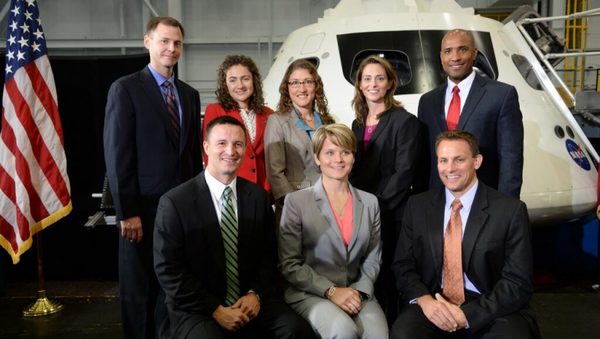WASHINGTON, August 20 (by Karin Zeitvogel for RIA Novosti) – NASA on Tuesday welcomed its newest astronauts – four men and four women who grew up on farms, military bases and in suburbia across the country, studied “hard science” in college, and have a wide range of professional experience from researching penguins in Antarctica to flying US fighter jets.
“They not only have the right stuff professionally, physically and personally, they also represent the full tapestry of American diversity,” NASA Administrator Charles Bolden said at a news conference to introduce the astronaut class of 2013.
“And with half of them being women, this is the highest percentage of women ever in a class of astronaut candidates,” Bolden added.
All in their mid-to-late-30s, the new astronauts shared some tips on how to be chosen to join the select ranks of NASA spacefarers, and how they stood out in the pool of more than 6,000 Americans who applied 18 months ago.
Physical fitness is a must for would-be astronauts, as is US citizenship and studying a “hard science” – physics, chemistry, biology, a branch of engineering -- at a university, said Jessica Meir, who is leaving a job as an assistant professor of anesthesiology at Harvard Medical School to become an astronaut.
All of the new astronauts have multiple science degrees and several years of work experience, but, “We all took very different paths to get here,” Army Maj. Anne McClain, who has played rugby on the US women’s national team, said.
“My advice to young people is to find something you’re passionate about, that you enjoy doing so that if you never get to the step of becoming an astronaut, you can look back and be satisfied,” she said.
New astronaut Navy Lt. Cmdr. Victor Glover said the application process included a requirement to compose a tweet, a limerick or a haiku poem.
“I did a limerick and it goes:
‘Eyes fixed gazing off into space
My mind in awe of the human race
This is all dizzying to me
Because I gave so much blood and pee
Happy to be here via the colonoscopy place.’”
“It’s funny if you had to go through this interview process, specifically the medical portion,” Glover said to laughs and applause from the small audience at Johnson Space Center in Houston, Texas.
The other new astronauts are: Navy Lt. Cmdr. Josh Cassada; Air Force Lt. Col. Nick Hague; National Oceanic and Atmospheric Administration (NOAA) Station Chief in American Samoa Christina Hammock; Marine Corps Maj. Nicole Mann; and Maj. Andrew Morgan, who has served as an emergency physician and flight surgeon for Army special operations.
The new group of astronauts “will be among those who will have the opportunity to fly on new commercial space transportation systems that are now under development, and more importantly, they will be among those who plan and perhaps carry out the first human missions to an asteroid and on to Mars,” Bolden said.
But for the next few years, they will undergo training to prepare them for missions to the International Space Station (ISS), a key stepping stone before NASA ventures deeper into space, he said.
The new astronauts will work in “support roles for Station crews before they are assigned onto missions,” Bob Behnken, chief of NASA’s astronaut office said.
In addition to learning about operations on board the ISS and “things the crews on board are going through,” the astronaut class of 2013 will also be given flight training in a twin-engine supersonic T-38 Talon jet trainer, and will visit NASA centers around the United States, he said.
Once their training is completed, the new astronauts will “help us continue to lead the world in exploration and they will become the role models for boys and girls, men and women around the world,” Bolden said, ending his introductory speech for the new astronauts almost as poetically as the limerick that Glover penned as part of his application to join NASA.
“Their journey begins now, and the nation, as it always has, will be right beside them reaching for the stars,” Bolden said.


